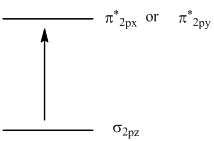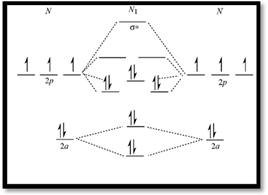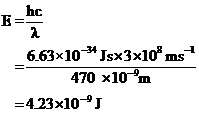
Consider a N2 molecule in its first excited electronic state, that is, when an electron in the highest occupied molecular orbital is promoted to the lowest empty molecular orbital. (a) Identify the molecular orbitals involved and sketch a diagram to show the transition. (b) Compare the bond order and bond length of N2* with N2, where the asterisk denotes the excited molecule. (c) Is N2* diamagnetic or paramagnetic? (d) When N2* loses its excess energy and converts to the ground state N2, it emits a photon of wavelength 470 nm, which makes up part of the auroras lights. Calculate the energy difference between these levels.
(a)
Interpretation:
The molecular orbital involved in transition should be identified and to sketch the transition. Bond order of  and
and  should be found and the bond length should be compared. The magnetic properties of
should be found and the bond length should be compared. The magnetic properties of  should be found out. The energy difference of the given transition should be determined
should be found out. The energy difference of the given transition should be determined
Concept Introduction:
- In molecular orbital theory, when the bonding takes place the atomic orbitals that take part combine to get a new orbital that has the properties of the whole molecule. The newly formed orbitals are known as molecular orbitals
- The bond order gives an idea about the stability of a molecule. It can be calculated using the molecular orbital theory. The stability of a molecule increase as the bond order increases.

- Paramagnetic species contains at least one unpaired electrons and can be attracted towards magnetic fields. Diamagnetic species does have any unpaired electrons. That is spins of all the electrons are paired. It slightly repelled towards the magnetic fields


To identify: molecular orbital involved in transition and to sketch the transition.
Answer to Problem 10.113QP
The transition sketch is,

Explanation of Solution
In molecular orbital theory, when the bonding takes place the atomic orbitals that take part combine to get a new orbital that has the properties of the whole molecule. The newly formed orbitals are known as molecular orbitals and only contain a maximum of two electrons. The number of newly formed molecular orbital is equal to the number of atomic orbitals involved in the bonding.
There are two types of molecular orbitals,
- a) Bonding molecular orbitals: sharing of electron density is between the nuclei and has comparatively lower energy and fills first.
- b) Antibonding molecular orbitals: Two nuclei is pulled by the electrons density in opposite direction and has higher energy comparing to bonding molecular orbital.
Molecular orbital diagram of  is given below
is given below

Figure 1
In the ground state of  the electrons are in
the electrons are in  orbital when the
orbital when the  gets excited by getting energy the electron move to
gets excited by getting energy the electron move to  orbitals.
orbitals.
The diagram that showing transition is given below,

(b)
Interpretation:
The molecular orbital involved in transition should be identified and to sketch the transition. Bond order of  and
and  should be found and the bond length should be compared. The magnetic properties of
should be found and the bond length should be compared. The magnetic properties of  should be found out. The energy difference of the given transition should be determined
should be found out. The energy difference of the given transition should be determined
Concept Introduction:
- In molecular orbital theory, when the bonding takes place the atomic orbitals that take part combine to get a new orbital that has the properties of the whole molecule. The newly formed orbitals are known as molecular orbitals
- The bond order gives an idea about the stability of a molecule. It can be calculated using the molecular orbital theory. The stability of a molecule increase as the bond order increases.

- Paramagnetic species contains at least one unpaired electrons and can be attracted towards magnetic fields. Diamagnetic species does have any unpaired electrons. That is spins of all the electrons are paired. It slightly repelled towards the magnetic fields


To identify: Bond of order of  and
and . Also to compare its bond length
. Also to compare its bond length
Answer to Problem 10.113QP
Bond order of  and
and  is 3 and 2 respectively. Also the bond length of
is 3 and 2 respectively. Also the bond length of  is longer than
is longer than  .
.
Explanation of Solution
Electronic configuration of excited nitrogen molecule  is
is 
The bond order gives an idea about the stability of a molecule. It can be calculated using the molecular orbital theory. The stability of a molecule increase as the bond order increases.


Electronic configuration of excited nitrogen molecule  is
is 
The bond order gives an idea about the stability of a molecule. It can be calculated using the molecular orbital theory. The stability of a molecule increase as the bond order increases.


Bond order of  is 3 whereas
is 3 whereas  is 2.
is 2.
Therefore, the bond length of  is longer than
is longer than  .
.
(c)
Interpretation:
The molecular orbital involved in transition should be identified and to sketch the transition. Bond order of  and
and  should be found and the bond length should be compared. The magnetic properties of
should be found and the bond length should be compared. The magnetic properties of  should be found out. The energy difference of the given transition should be determined
should be found out. The energy difference of the given transition should be determined
Concept Introduction:
- In molecular orbital theory, when the bonding takes place the atomic orbitals that take part combine to get a new orbital that has the properties of the whole molecule. The newly formed orbitals are known as molecular orbitals
- The bond order gives an idea about the stability of a molecule. It can be calculated using the molecular orbital theory. The stability of a molecule increase as the bond order increases.

- Paramagnetic species contains at least one unpaired electrons and can be attracted towards magnetic fields. Diamagnetic species does have any unpaired electrons. That is spins of all the electrons are paired. It slightly repelled towards the magnetic fields


To identify: The magnetic properties of 
Answer to Problem 10.113QP
 is diamagnetic
is diamagnetic
Explanation of Solution
Paramagnetic species contains at least one unpaired electrons and can be attracted towards magnetic fields. Diamagnetic species does have any unpaired electrons. That is spins of all the electrons are paired. It slightly repelled towards the magnetic fields.
Electronic configuration of excited nitrogen molecule  is
is 
Even though there are unpaired electrons, the spin of the electrons was not change in the time of transition. All the electrons are paired so it is diamagnetic.
(d)
Interpretation:
The molecular orbital involved in transition should be identified and to sketch the transition. Bond order of  and
and  should be found and the bond length should be compared. The magnetic properties of
should be found and the bond length should be compared. The magnetic properties of  should be found out. The energy difference of the given transition should be determined
should be found out. The energy difference of the given transition should be determined
Concept Introduction:
- In molecular orbital theory, when the bonding takes place the atomic orbitals that take part combine to get a new orbital that has the properties of the whole molecule. The newly formed orbitals are known as molecular orbitals
- The bond order gives an idea about the stability of a molecule. It can be calculated using the molecular orbital theory. The stability of a molecule increase as the bond order increases.

- Paramagnetic species contains at least one unpaired electrons and can be attracted towards magnetic fields. Diamagnetic species does have any unpaired electrons. That is spins of all the electrons are paired. It slightly repelled towards the magnetic fields


To determine: The energy difference of the given transition.
Answer to Problem 10.113QP
The energy difference of the given transition is 
Explanation of Solution
The energy of light is calculated below.
Given,
The wavelength of light is  .
.
Planck’s constant is 
Speed of the light is 
The energy of light is calculated is calculated by the equation,


Substituting the given values in the equation,

The energy difference of the given transition is

Want to see more full solutions like this?
Chapter 10 Solutions
CHEMISTRY (LL) W/CNCT >BI<
- Organic Chemistry Esterification reactions 1. Write the steps to prepare ester. 2. Write complete reaction of ethanol and acetic acid to make ester. 3. What does ester smell like? What are the uses of ester. 4. What the role of sulfuric acid in the esterification reactionarrow_forward11. Complete the following esterification reaction with names of all the reactants and products under. Hint: Remove the water and end up with ester R-C-OH + ROH R-C-OR + H₂O A carboxylic acid An alcohol An ester Water BYJU'S H-C-C O-H Нин C-C-C-H HAAA H O-C-C-C-H AAA Ethanoic acid Propanol Water Propyl ethanoate By com CH3COOH + CH3CH2CH2CH₂CH₂OH → Practice for alcohols aldehydes and ketones: 12. Draw the structures from the following names mixed of alcohol/aldehyde and ketone: a. 4-methyl cyclohexanone b. 3-methyl-2-pentenal c. 2,3-dimethylcyclohexanone d. 1,3propanediol or Propane 1,3 diol 13. Write systematic names for the following compounds identify functional group: a. b. (CH3)2CH-C OH c) CH(CH₂)-- OH -,-,arrow_forwardmay you please show all steps! i am having a hard time understanding and applying in this format, thank you!arrow_forward
- 10. Complete the substitution reaction of 2 pentanol with these reagents. Reagents & Reaction Conditions use practice sheet. Please write only major products, minor product like water, other gases are not required. Hint: In substitution of alcohol, we generally substitute OH group with Halogens like cl, Br, F using some reagent containing halogens. Ensure to add halogens to the same carbon number where you are removing OH from Examples Alcohols can be converted to Alkyl Halides with HX acids HBr H₂O HCI + H₂O HI + H₂O CH,CH₂OH + SOCI₂ CH,CH₂OH + PCI₁₂ A BBYJU'S CH CHCI + SO₂+ HCI CH₂CH CIP(OH), + HCI CH,CH₂OH + PCI CHCHCI + POCI + HCI CH,CH₂OH + PBr, CH,CH,Br + P(OH), + HBr 1. Reaction with HBr with 2 Pentanol 2.Reaction with HI with 2 pentanol © Byjus.com 3.Reaction with HCI+ZnCl,, with 2 pentanol (Zncl2 is catalyst no role) 4.Reaction with SOCI,, with 2 Pentanol 5.Reaction with PBr; or PCl, with 2 pentanolarrow_forward3. Is 2-methyl-2-propanol a primary, secondary, or tertiary alcohol? Write out the structures of 2-methyl-2-propanol and also any oxidation products of 2- methyl-2- propanol. If there is more than one oxidation product, give the structure of each of the products. 4. 2-Propanol is the IUPAC systematic name of this alcohol. It has a common name by which it is much better known (You'll see it in the grocery store or pharmacy). Give that common name 5. Aldehydes can be synthesized by the oxidation of. Please choose from below choices A. Primary alcohols B. Secondary alcohols C. Organic acids D. Inorganic acids 6. Tertiary alcohol Can undergo oxidation. yes or no. ? If yes then answer the product.arrow_forwardFinish the reactions hand written pleasearrow_forward
- Part A Identify each alcohol as primary, secondary, or tertiary Drag the appropriate items to their respective bins. CH₂ H₂C- -C-OH HO CH₂ Primary Он OH CH₂ OH CCH₂OH CH₂ сн Secondary Tertiary Reset Help CH,CH₂ (CH)CHCH,OH CH,CH,CH,CCH, CHOH CH₂ Different types of alcohol groups Alcohol and its reaction: 8. Combing two alcohol molecules below and completing the reaction with Product .( Hint Reaction called etherification as ether is formed and name the ether once you complete the reaction. Hint.: R-O-H+H-O-RR-O-R Do the reaction: CH₂OH + CH₂OH---→ + H-O-H 9. Write the reaction of formation of alcohol from alkene by adding water: Addition reaction also called hydration reaction as we are adding water which occur always in presence of acid Hint: Break the double bond and add H and OH if symmetrical then add anywhere if unsymmetrical then follow Markovnikov rule H should go to that double bone carbon which has more hydrogen CH2=CH2 + H₂O-→arrow_forwardComplete the reaction hand written pleasearrow_forwardPredict the major products of this organic reaction: HBr (1 equiv) cold ? Some important notes: • Draw the major product, or products, of this reaction in the drawing area below. • You can draw the products in any arrangement you like. • Pay careful attention to the reaction conditions, and only include the major products. • Be sure to use wedge and dash bonds when necessary, for example to distinguish between major products that are enantiomers. • Note that there is only 1 equivalent of HBr reactant, so you need not consider the case of multiple additions. dm Re Explanation Check ©2025 McGraw Hill LLC. All Rights Reserved. Termarrow_forward
- b) Use curved arrows to show the reaction of the radical with hydrogen bromide. Br: Br H .. Answer Bankarrow_forwardIndicate the reaction products when CH3COCH2COOCH2COOC2H5 (ethyl acetoacetoacetate) reacts with 1º OH-/H2O and 2º H3O+arrow_forwardDraw the formula of the compound 4-cyclohexyl butanamide?arrow_forward
 Chemistry & Chemical ReactivityChemistryISBN:9781337399074Author:John C. Kotz, Paul M. Treichel, John Townsend, David TreichelPublisher:Cengage Learning
Chemistry & Chemical ReactivityChemistryISBN:9781337399074Author:John C. Kotz, Paul M. Treichel, John Townsend, David TreichelPublisher:Cengage Learning
